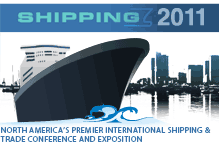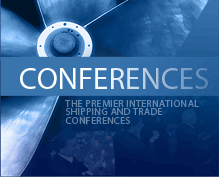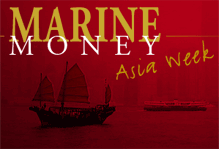
The LNG Market
By David Bull, Consultant, Ocean Shipping Consultants Ltd, UK
The past year has witnessed major developments for the LNG shipping market, with a record number of vessels ordered and delivered and continued development in vessel size and propulsion equipment for newbuildings.
2005 is set to be just as dramatic, with a total of 21 vessels scheduled to be delivered this year, totaling 2.9m cu.m. The size of the orderbook has been steadily growing and has now surpassed 100 vessels to be delivered through 2008. Figure 1 shows the orderbook for 2005 onwards.
However, the healthy state of the orderbook may not translate into short-term gains for the shipping market. With such a large influx of vessels during 2005 – equivalent to approximately 13% of the current fleet in vessel numbers and over 15% in cubic capacity – the short-term result is likely to be vessel over-supply. The effect of this is that there may well be idle or semi-utilised tonnage witnessed throughout the coming year. Continue Reading
New Tax Legislation Set to Make the U.S. a More Attractive Venue for Shippers
By James K. Wall and Jorge Pascual, Ernst & Young International Tax Services Group
On October 22, 2004, the U.S.A. passed the American Jobs Creation Act of 2004 (the “Act”), the largest and most significant tax reform since 1986. The Act contains hundreds of new or amended provisions which will affect practically every business. This tax alert summarizes the provisions that apply specifically to international transportation activities.
Repeal of Foreign Base Company Shipping Income
Current Law
Under current law, U.S. 10% voting shareholders of a controlled foreign corporation (“CFC”) must currently include in income as a deemed dividend their pro rata share of the CFC’s earnings from certain specified categories of “Subpart F” income. One such category, foreign base company shipping income, generally includes income derived from the use of an aircraft or vessel in foreign commerce, the performance of services directly related to the use of any such aircraft or vessel, the sale or other disposition of any such aircraft or vessel, and certain space or ocean activities. Foreign base company shipping income also includes dividends and interest that a CFC receives from certain foreign corporations and any gain from the disposition of stock in certain foreign corporations, if the dividends, interest or gains are attributable to foreign base company shipping income. In addition, incidental income derived in the course of active foreign base company shipping operations, foreign exchange gain or loss attributable to foreign base company shipping operations, and a CFC’s distributive share of income from a partnership or trust if the income would have been foreign base company shipping income had it been realized directly by the CFC also constitute foreign base company shipping income. Accordingly, U.S. 10% voting shareholders of a non-U.S. shipping company that is a CFC generally are subject to current tax on their share of the CFC’s shipping income. This generally has made operating a shipping company as a CFC unattractive. Continue Reading
The Dry Bulk Market
By Nicolai Hansteen, Lorentzen & Stemoco
Never before have shipowners made more money in the dry bulk market than they did last year. China’s ferocious demand for iron ore and coal put severe pressure on international mining companies, inland logistics and port facilities, as well as the few available vessels for charter. The result was freight rates hitting all-time-high levels, first in February and then again in December. There is reason to believe that the market will soften moderately this year, as relatively many newbuilding vessels will be delivered from shipyards. But the unprecedented volatility is due to persist, with potentially another peak looming next winter.
The dry bulk market continues to be driven primarily by China’s increasing consumption of steel products. Last year, China consumed about 280 million tons of steel, accounting for roughly 30 percent of the world total. Based on gross domestic product, China is twenty times more steel intensive than the United States. The construction sector is the largest end-user in China, taking over half of the required steel for large-scale infrastructure projects, such as the Beijing Olympics in 2008 and the Shanghai Expo in 2010. The construction sector is less exposed to a slowdown in Chinese economic growth than other end-users such as manufacturers of cars, home appliances and consumer electronics. Continue Reading
Convertible Market Opens to Shipping
In remarkably similar deals, first OMI and then Seacor used that form of exotic financing that has so long stayed on the perimeter of shipping finance: the convertible bond.
OMI (NYSE: OMM) was able to capture and monetize the value of its stock’s volatility when it sold $250 million of 2.875% convertible unsecured notes due 2024 through sole Bookrunner Jefferies & Company on the 29th of November. Each $1000 face amount bond comes with the right to convert into the value of 32.5 shares of common stock, or $30.70, a premium of about 46.5% at the time of the deal. OMI stock’s 42% price volatility over the past 100 days undoubtedly contributed to the deal’s superior pricing.
One week later, diversified offshore services company Seacor (NYSE: CKH) priced its third convertible issue since going public through Credit Suisse First Boston (the company’s last convertible issue was in 1996). The $250 million in notes, inclusive of the $50 million greenshoe, also bears interest at a fixed rate of 2.875% and matures in 2024. Each $1000 in principal will be convertible into 13.6705 shares of the company’s common stock, representing a substantial but slightly less impressive 40% premium to the price of Seacor’s stock when the deal closed. The first call dates for both deals will be in 2011, with repurchasing prices being 100% of the principal amount of the notes plus accrued and unpaid interest. Continue Reading
The Container Shipping Market
By Charles de Trenck, Citigroup Smith Barney
Past Its Peak and Preparing for Volatile Downside Moves
Despite trading calls to the upside, most recently this past summer, we believe the cycle is now moving past its prime and downside risks will begin to crowd out upside opportunity. Many people have noted our view as among the most bearish. But the issue is bearish at what price point – our view is not bearish at all price points but is rather more about trading opportunities around certain valuations.
We are looking for a post Chinese New Year seasonal correction from lofty highs in the dry bulk market and a 2H05 capacity-led down turn in container shipping (higher risk 2006 but depends on demand growth in 2H05 against sizeable acceleration of deliveries in 2H05). In theory and from physical markets perspective, these two markets are not strongly related, given that these sub-industries exhibit different specific dynamics. However, in the big picture and in practice, the two sub-sectors can be quite strongly related given a high degree of correlation between the BDI (Baltic Dry Index) and shipping shares (and even deep cyclicals) in general. Continue Reading
COME TO DUBAI: WHERE SHIPPING IS ABOUT TO TAKE OFF
By Kevin Oates
On 2nd February 2005, Marine Money will host its first annual Marine Money Gulf Ship Finance Conference at the Grand Hyatt Hotel in Dubai. We have chosen Dubai because it is a location that epitomises the growth and development of our markets. And it is not only Dubai that is growing in the region. Abu Dhabi, Kuwait, Qatar, and even Iran and Iraq all play a part in the region’s movement towards the fulfillment its potential. The whole region is developing rapidly, and we at Marine Money believe that shipping and shipping finance will be part of that development.
Two very different Dubai-based businesses epitomise the growth and vision of the region. The first business, Dubai Maritime City, demonstrates the vision of Dubai’s leaders who are creating a purpose-built Maritime City on land reclaimed from the sea which will effectively “cluster” all shipping related services into one designer built, state-of-the-art city suburb. The second business, Simatech Shipping LLC, demonstrates the vision of an entrepreneur in shipping who takes his expertise and, within a decade, grows a company from scratch to one with 12 ships, six newbuildings to be delivered, and the position of foremost container feeder company in the Gulf region. Continue Reading
CMB spins off Euronav and Creates value
By Andreas Vergottis
Following closely from the spin off of Exmar around the middle of last year, CMB completed the process of rationalisation by spinning off Euronav in early December.
The slimmed-down CMB now just comprises the dry bulk Bocimar division, which we shall refer to alternately as the “new CMB” and as “Bocimar.” At the end of this process, investors are left with three specialised companies, these being:
Bocimar Dry bulk focus
Euronav VLCC tanker focus
Exmar Gas shipping focus
If ones wanted to be extremely purist, Exmar could itself be split into LPG and LNG parts, but that does not seem terribly necessary. Continue Reading
Geden Holdings LTD: A Capital Markets Candidate
By Kevin Oates
When one thinks of shipping nations in the eastern Mediterranean, one thinks immediately of Greece. The Greek controlled fleet is the largest in the world and a number of the top Greek owners have become household names, or at least “Investment House” names, in the last decade. Furthermore, the Greeks have been incredibly active over the last few years in the newbuilding arena, constructing dry bulk carriers from Handymaxes to Cape Sizes, crude carriers from Panamaxes and Aframaxes to Suezmaxes and VLCC’s, product carriers and so on. And this newbuild activity has had its fair share of press and market coverage.
Across the Aegean, less is heard. The revival in the Turkish maritime industry has attracted considerably less attention. Perhaps that is because a number of banks and insurance companies had their hands burned in the early to mid 1990′s. Those memories last, and the fact is that many financiers today just turn up their noses when a Turkish shipping transaction is mentioned. Clearly they have the right to do so and, undoubtedly, there are still certain aspects of country risk, flag issues and jurisdictional issues which make some banks nervous.
The fact is, however, that there is now a new breed of Turkish owner. The vessels are modern; the management is Western and fully compliant with all the latest IMO and ISM regulations; the legal structure is more in line with what is found in Greece and other “comparable” maritime nations; the vessel owning companies are part of a corporate structure which gives additional comfort over and above the normal mortgage and assignment of earnings and insurances.
Flights Of Fancy: Shipping In a New World Order
By Jens Alers – Atlantic Marine LP, Bermuda, Member of the Schulte Group
Captain Eric Wong, rising at dawn from a good night’s rest in his onboard family quarters, watched the 3D plasma screen on the control panel as his ship approached the offloading platform. The “Nautilus” was one of sixteen Ultra Large Water Carriers, or ULWCs, in the Aqualiner fleet. Discharging her cargo of 500 acre-feet of water, approximately equivalent to 650,000 tons, was scheduled to take about six hours.
The precious load would soon flush into the distribution system of the New York-New Jersey- Philadelphia metro area, quenching the thirst of its 85 million people for just a few days. It was a mere drop, soon to be consumed in the hot and burgeoning marketplace for fresh water.
The vast metropolis, like so many other mega-cities in the US, had signed a 50 year supply contract with Aqualiner Marine to receive the glacial run-off from Greenland, Northern and Western Canada, and as far afield as Norway and the Malayan provinces of the Silk Route Alliance.
TITLE XI FINANCING AND U.S. MARITIME POLICY
By Mark P. Schlefer, Esq.
The Congress has established five promotional programs to achieve an adequate merchant marine. They are: long-term financing under Title XI of the Merchant Marine Act, 1936 (the “Act”); cabotage; capital construction funds; the Maritime Security Program; and cargo preference. There is also 200 per cent ten-year declining balance tax depreciation.
The Title XI program deals with most of the important aspects of the economics of American shipping and shipbuilding; it is also readily subject to criticism, because it involves the government taking risks. It is easy to second guess a risk- taker if the risk eventuates.
The U.S.-Flag Merchant Marine
The five programs have failed to achieve the objectives. In the cabotage trades, only the oil companies, Tote in the Alaska trade and, to a limited extent, Matson in the Hawaii trade are in the process of renewing their fleets. Hawaii is served by about a dozen antiquated steamships, which should have been scrapped years ago. The same is true of the Puerto Rico trade. Most of the 47 subsidized ships under MSP are ancient tonnage. The bulk cargo preference trades, except for two new foreign-built ships, are served by old ships, generally built in foreign yards. These failures call for study and specific recommendations for corrective action. Continue Reading







